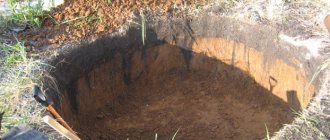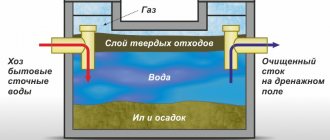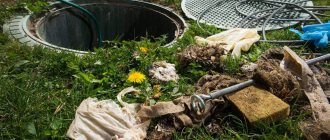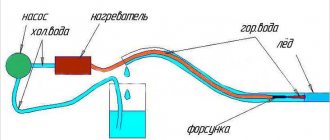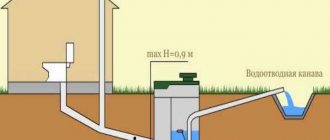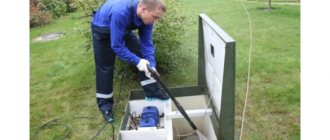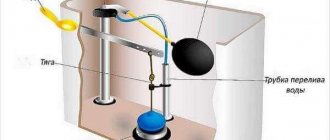Choosing the right installation location
When choosing a place to build a septic tank without pumping it yourself, you need to be guided by the requirements of sanitary standards and the recommendations of specialists. According to them, the treatment plant should be located:
- no closer than five meters from residential buildings. But you shouldn’t move the septic tank too far from the house. The fact is that the longer the line, the greater the risk of blockages in the pipe. The best option can be considered 10-15 meters from the building;
- no closer than 50 meters from the water source (well or well). Everything here will depend on the soil at the dacha and the direction of groundwater flow. If the ground is permeable (for example, sand), then the distance from the water source should be more than 50 meters. Also, the septic tank cannot be located higher in the direction of groundwater flow from the well or borehole;
- You cannot install a septic tank near an adjacent area. Not a single person will be happy with such a neighborhood. Therefore, it is worth retreating at least a meter from the fence or fence, and preferably more.
In addition, experts do not recommend building a septic tank in areas where trees or other large vegetation grow nearby. Their roots can damage the sealed first compartment, causing harm to the environment.
Pumping using professional equipment
Contacting a specialized company that provides sewerage services is the most common option for cleaning local sewage systems. To carry out cleaning, a special machine is used for pumping out a septic tank, on which a powerful pump is installed, a container for collecting pumped out wastewater and a hose lowered into the installation hatch.
A more modern analogue of sewage disposal equipment is sludge sucking machines. With their help, you can clean a septic tank of any size. The advantage of these machines is that they do not have to drive directly to the well.
If septic tanks are pumped out using a sludge sucking machine, the length of the hose allows the work to be carried out when the machine is located at a distance of up to 40 meters from the installation.
Despite the fact that the services of vacuum cleaners are not cheap, it is worth contacting professionals. In this case, the owners will not have to do anything; all unpleasant procedures will be performed by specialists using special equipment.
Features of the device depending on the material
You can build a septic tank without pumping and smell yourself. For this use:
Let's look at each design in more detail.
Option #1 - brick septic tank
To make a septic tank without pumping, clinker bricks are chosen. The shape of the sump can be round or rectangular. For better waterproofing, it is advisable to treat the external walls of the septic tank with a special mastic and cover it with clay around the entire perimeter by about 20 cm. The internal surface is treated with cement mortar.
The bottom of the chambers, except the last one, must be concreted so that untreated waste does not seep into the ground. The bottom of the last tank is covered with a layer of sand and crushed stone, and the walls are laid out with small gaps. This will help excess filtered water seep into the soil. The tanks are connected to each other using tees.
The walls of the last chamber of the septic tank are laid out from bricks with small gaps so that excess moisture drains into the ground through them.
Option #2 - monolithic concrete structure
To seal the first chambers of a monolithic septic tank, the base is poured with concrete on top of a sand “cushion”. After the solution hardens, formwork is constructed and the walls of the structure are poured with concrete. In this case, it is necessary to arrange overflows between the chambers. For this purpose, sewer tees are used. The top of the structure is also filled with mortar. In this case, control holes are left, which are covered with hatches. To improve drainage, pipes are dug into the bottom of the last chamber, and the ground is not filled with mortar, but covered with crushed stone.
The size of the first chamber of a three-chamber monolithic septic tank can be half of the entire structure or be equal to each of its components. The walls and bottom of a monolithic structure must be completely sealed
For the strength of concrete, when constructing a monolithic septic tank, it is necessary to use reinforcement.
Option #3 - septic tank made of concrete rings
The diameter of the reinforced concrete rings is different, which must be taken into account when calculating the size of the septic tank. Typically, no more than 4 concrete products are used for one tank. Due to the heaviness of the components, it is advisable to use special equipment for the construction of such septic tanks. Bury the rings sequentially.
Having installed the first element in its location, they make a dig under it. As the first ring is lowered, the following elements of the septic tank are installed. The parts are fastened together using protruding reinforcement. The seams between the rings are carefully sealed with mortar and covered with waterproofing. The bottom of sealed structures is concreted.
After installing the rings for the septic tank, the seams between them are sealed with mortar and covered with a waterproofing compound. This prevents untreated waste from seeping into the soil
To seal the seams between the rings, waterproofing agent, bitumen mastic, hydrotex or other waterproofing compounds are used.
Having thus constructed the required number of tanks, overflow pipes are laid between them. All chambers are covered with hatches from above. For security, a clay “castle” is made around the structure.
Option #4 - using plastic containers
Eurocubes are often used as plastic containers for septic tanks. Before installing them, it is necessary to make holes for transition and ventilation pipes. After which the containers are welded or fastened together using reinforcement and lowered into a pre-prepared pit. To avoid the structure being squeezed out by groundwater, anchoring must be done.
Eurocubes are fully prepared for installation in the ground. To prevent them from moving relative to each other, a durable metal frame is welded
Regardless of what the septic tank is made of, it must be reliable and durable. We must not forget about the safety of such structures. Therefore, septic tanks without pumping can only be built in places with low groundwater levels.
Cleaning methods
How can you pump out sludge from septic tanks or the contents of cesspools? It must be said that the choice of methods is small; there are only two full-fledged cleaning methods and one more method that can be called auxiliary. So, how to pump out the contents of cesspools and septic tanks:
- Use of professional sewer equipment. This is the simplest, but at the same time expensive method;
- Self-cleaning (using a fecal pump). This option is not used often because performing all the necessary operations is not a very pleasant job;
Advice! Self-pumping of the contents of cesspools or sludge from a septic tank is rarely practiced also because owners have difficulties with the safe disposal of pumped sludge.
- An auxiliary cleaning method involves the use of special biological preparations. Bacteria, of course, cannot completely eliminate sediment, but they are quite capable of reducing its volume.
When pumping out the contents of a septic tank, not only the sediment is removed from it, but also all the water, that is, the container remains practically empty. If the body is made of plastic, then you cannot keep it empty; due to its low weight, it can float up, lifted by soil waters.
Therefore, after the sludge has been pumped out of the septic tank, you need to fill it, using clean water for this. If a concrete or brick septic tank is built on the site, then there is no need for such a precaution; even if the water in the septic tank is at the lowest level, such a heavy structure will not float up. Water does not flood even after cleaning the cesspools.
How often should cameras be cleaned?
How often should the septic tank be pumped out and when should it be done? The answer to this question depends on many factors:
- Model;
- Regularity of sewer use;
- Family size, etc.
In most cases, sludge has to be pumped out of a septic tank 1-2 times a year. And when using cesspools, their contents must be pumped out as they fill.
Of course, when using biological products, the process of pumping out sludge does not need to be repeated so often, however, such an ideal design as a septic tank without pumping and odor does not exist. Any, even the most modern installation must be periodically cleaned of sludge using a built-in or household sewage pump.
Advantages of a cesspool without pumping
A rationally designed and constructed sewage system will not only make a summer cottage comfortable for living. The system has many advantages:
- Ease of self-construction;
- Possibility of using various materials, including concrete;
- Increased time interval between pumping cycles.
- Low cost and minimal maintenance costs.
When planning a sewer system without the need for pumping, consider several nuances. Carefully choose the installation location, control the absorption capacity of the system, and specific odors in the property. Avoid using household chemicals to clean the system - they may react with organic matter.
Operating principle
If you want to set up an autonomous sewage system at your dacha or country house, then you cannot do without a device such as a septic tank.
You can create such a system with your own hands. The main thing is to know the operating principle of the septic tank and its components. So, the wastewater treatment system includes:
- two or more containers connected to each other by tubes;
- ventilation system (holes or shafts) for each section of the septic tank;
- sealed lids (hatches) over each container.
Wastewater from the sewerage system enters the first container. It plays the role of a sump, so it must be absolutely sealed. Here solid fractions settle to the bottom. They are subsequently processed by anaerobic bacteria. These microorganisms enter the septic tank naturally, because they are constantly present in the environment. But for more efficient operation of the device, you can introduce bacteria manually, simply pour biological products (they are sold in specialized stores) into the sewer system.
During their life, microorganisms produce gases. To prevent them from accumulating in the container, it is necessary to provide ventilation. To do this, it is enough to equip a hole in the upper part of the container; you can build a shaft above it (install a pipe). Since the process of decomposition of organic compounds under the influence of microorganisms occurs slowly, a sharp unpleasant odor will not appear in the dacha.
Clarified water (after solid fractions have precipitated) flows through connecting tubes into the second container. If your septic tank installed in a country house or country house consists of more than two sections, then the second of them is also made airtight. Here the process of decay under the influence of anaerobic microorganisms will continue. These bacteria will appear here from the first container, but you can introduce them yourself through the upper hatch.
If the septic tank contains only two containers, then the second one is made without a bottom. More precisely, its base will be made of a layer of crushed stone and sand. Through such a bottom, water that has already been purified in the sump and under the influence of microorganisms will freely flow into the soil.
In order for such a septic tank to work effectively at your dacha or homestead for many years, you should follow some rules:
- Firstly, no solid inorganic objects should fall into the sump. They simply will not be processed by bacteria and will gradually fill the entire container, which will force you to clean the septic tank ahead of time;
- secondly, chemicals (especially those containing chlorine compounds) should not enter the sewer system in large quantities. Such effluents will harm the colony of microorganisms, and therefore reduce the efficiency of the septic tank. As a result, you will have to purchase biological products to restore the bacteria population.
If you follow these simple rules, the sewage treatment device will work for 15-20 years. In this case, there will be no need to call a sewer truck to pump out accumulated sewage.
How often should you clean?
The period of complete drainage of the settling tank chambers depends on its capacity and filling. Experts recommend pumping out sewage at least once a year. However, you should check the tank's fullness once a quarter.
Each device has an overflow pipe or chamber partition. As wastewater moves through the pipe, purified water passes into another section of the device. But if sewage does not come from the house, the partition is dry. Opening the lid of the container, you can see that the water has reached the middle of the pipe or has completely blocked the passage - it’s time to pump out the second tank.
When is the best time to clean tanks?
The best time to empty VOCs is in the fall. All year round, the plumbing fixtures in the house work constantly, and this practically does not depend on the time of year. Of course, we can say that in winter the water consumption, which means the work of the sewerage system, is a little more, only 10-15%.
In winter, pumping is complicated by weather conditions. In some houses, the tanks are not located deep, the lid and head freeze in the ground, and frost forms on the walls. Every time the container is opened in cold weather, it is accompanied by evaporation and additional freezing.
Before winter (preferably during the first frost), the installation is pumped out. This will allow you to use the sewer all winter without problems and not even open the tank.
Proper cleaning in winter
It is not always possible to pump out the septic tank at the right time. When getting rid of sewage in winter, you must follow the following rules:
- A lot of snow. The top of the tank must be dug out the day before cleaning. Cover the top with a soft canopy or unnecessary clothing.
- The hatch cannot be opened until the pumping equipment is ready.
- After placing the hose or pump in the container, the top part should be covered with a soft canopy or a piece of glass wool. So that the cold does not penetrate inside.
- Upon completion of work, remove all water from the hoses.
The principle of operation of the design without pumping
Waste is discharged into the first tank. Pre-cleaning is performed there - heavy particles settle on the bottom surface, and light particles are discharged into a second container. Here they are finally filtered and discharged into one or more drainage wells. To prevent waste from entering your area, the chambers are sealed. The exception is the last one, on the walls or bottom of which small holes are made. They are designed to remove excess moisture. Solid particles settle on the walls and need to be removed periodically. The appearance of sediment can be prevented in several ways:
- prevent solid objects from entering the sump;
- control the removal of inorganic materials into septic tanks;
- reduce the access of chlorine-based chemical products into sewer lines.
By following the rules for the effective functionality of a septic tank, you can extend its operation up to 20 years without the need for sewerage services src=»https://mr-build.ru/wp-content/uploads/4/4/f/44faece9b522ee61bedc602ed68cdd6b.jpg» class=»aligncenter "width="850″ height="574″[/img]
What is a cesspool
A cesspool is a simple structure for draining wastewater. However, when installing it, you must adhere to certain requirements. Materials for construction can be:
- plastic;
- brick;
- metal;
- reinforced concrete (monolithic or prefabricated rings).
It is preliminarily determined whether the container will be sealed or whether liquid seepage into the ground is permissible. If the groundwater level is high, the construction of an impermeable structure is recommended. Under favorable conditions, it is possible to build a filter well, which is an absorption pit with a layer of sand and gravel at the bottom. Due to the absorption of liquid into the soil, calls for a sewer truck are made less frequently.
The best solution is to use a septic tank, since it usually includes two or three compartments where mechanical and biological wastewater treatment occurs. Despite the high efficiency of such installations, they also tend to silt and require periodic cleaning.
Types of sewer septic tanks without pumping
Systems are classified depending on the cleaning mode. A two-chamber structure is serviced once every 2-3 years, and waste from a three-chamber structure goes into a drainage well.
Two-chamber design - features of self-construction
The collector, consisting of two chambers, is convenient to use when people do not live independently at the dacha. The work is carried out following the technological sequence of actions:
- A pit is dug 3 m deep, the location for which is chosen according to the requirements of SNiP and the location of groundwater. Digging is carried out with a shovel or excavator.
- The bottom surface is covered with a cushion of sand and crushed stone, raising it by 15 cm.
- Formwork made of lumber is installed, reinforcement is carried out with ligation with metal wire.
- Two holes are made in the formwork where pipes are inserted. They form the beginning of the highway and the overflow channel.
- The formwork is filled with concrete mortar and distributed evenly with a rubber mallet. The entire cement mass is poured in one step.
- The bottom of the first tank is made of concrete, controlling the tightness of the section. In the sump, the waste liquid is separated - the solid fractions settle, and the water is poured into a second container. Solid sediments are decomposed with special preparations and an anaerobic complex.
- The second chamber is made without a bottom. Instead, a layer of crushed stone and gravel mixture is poured onto the ground, which filters wastewater.
- The overflow pipe is fixed, maintaining a slope of 30 mm per 1 linear meter. The height of the element is 1/3 of the well.
The septic tank is covered with similar concrete slabs. You can make them yourself or purchase them. The hatch cover is placed to check the filling of the chambers. The hole is filled with sand and the removed layer of soil. Clean the system every 2-3 years.
Sewerage without pumping - stages of arrangement
A septic tank without regular pumping of wastewater is relevant when people live permanently in a country house, private house or country house. The optimal option for sewer lines is three-chamber. The settling tank is made large, about ½ of the entire structure. Heavy waste settles in it, and the liquid enters the first compartment, from where, as it is full, it flows into the second. The last chamber of the septic tank ensures complete treatment of wastewater with its subsequent discharge into the drainage tank. To remove insoluble impurities, a pumping station is used. Pumping is carried out at intervals that depend on the volume of the sewerage system. To install a treatment facility from ready-made concrete rings, follow the following algorithm:
- Buy 9 concrete rings. For every 3 products you will need one cast iron hatch.
- Dig 3 pits, focusing on the diameter of the rings. Installation of tanks of standard parameters is carried out in pits 3 m deep and 2.8 m wide.
- Cover the first trenches with concrete pads.
- Lower the products into the ditches using a crane.
- Make holes in the finished tank through which you connect the connecting pipeline or perform ventilation. Seal the joints with concrete-based mortar.
- Fill the cavities between the rings and the soil with liquid glass, waterproofing, and bitumen mastic, which seal the communications and give them stability.
After installing the concrete forms, place hatches on them.
Is there a septic tank without pumping?
The sump does not need to be pumped out if the design has a drainage well with holes; filtered water goes into it. Silt still collects in such a chamber, although only a little. You will have to clean the deposits manually with a shovel and bucket.
The filtration plant consists of several physical and biological treatment chambers.
What does physical cleaning mean? The first chamber receives wastewater, which, according to its specific composition, is divided into heavy and light. The first ones sink to the bottom, and the water passes into the next compartment. The fraction at the bottom is met by biological microbes, which are designed to break down and dissolve hard deposits.
When processing wastewater, they release gas and water. Harmful substances are released to the surface through the gas outlet tube.
Important: the gas outlet tube must be clean so that gas escapes and does not accumulate in the chamber. Methane, formed as a result of the breakdown of molecules, is dangerous in dense concentrations.
Water after purification by bacteria is considered conditionally clean and does not need to be pumped out. Entering the drainage well, it goes into the ground on its own.
How does the design that does not require pumping work?
The design, which does not require regular pumping of wastewater, consists of several adjacent tanks. Usually two or three-chamber septic tanks are built. The first tank is a settling tank. As a rule, in a two-chamber septic tank, the volume of the first tank occupies three quarters of the entire structure, in a three-chamber septic tank, half.
Once in the first chamber, the wastewater undergoes preliminary treatment. In this case, the heavy fractions settle at the bottom, and the lighter ones flow into the second tank as the first one fills. In the last tank, the final purification of wastewater occurs, after which relatively clean water is sent to filtration fields or to a drainage well.
A layer of crushed stone is poured onto the bottom of the last chamber of the septic tank for drainage. This helps excess moisture go into the ground and not accumulate in the septic tank.
All tanks of such a septic tank, except the last one, are made airtight. Depending on the design, holes are made in the last chamber in the walls or bottom of the septic tank. This helps remove excess moisture and avoid having to pump out waste regularly.
Since in addition to organic substances, household waste contains insoluble impurities, even such a design must be periodically removed from the sediment that will accumulate at the bottom of the septic tank. This is done using household drainage pumps. The pumped out sludge can be used as fertilizer. The frequency of septic tank maintenance depends on its size and volume and composition of wastewater.
Pumping with a sewer machine
Removal and removal of liquid household waste is the task of a sewer truck. There are several types of this special equipment:
- vacuum;
- mixed;
- silt sucker.
The machine is equipped with special tools to perform the specified functions:
- sealed tank with a capacity of 5-7 cubic meters. m.;
- pump;
- hose for pumping out drains.
Typically, the volume of a cesspool does not exceed 5 cubic meters. m., which allows you to clean it completely in one go.
There are several ways to clean a pit, depending on the equipment used. Exists:
- vacuum cleaning – performed with a vacuum pump;
- hydrodynamic pumping - work is carried out in three stages: removal of wastewater, filling the container with water, cleaning the walls and repeated pumping;
- using a suction pump is the most cost-effective way to remove wastewater, bringing good results.
The use of sewage disposal machines allows you to clean the cesspool quickly and without the risk of contamination. When choosing this method of emptying a container with wastewater, you should provide access to the pit and take into account the length of the suction hose (it is 3-4 m). In case of greater depth of containers, it is necessary to take care of additional ways to clean its bottom.
During long-term operation of a structure, there is a need to soften the dense sediment on its walls. For these purposes, biological and chemical agents are used. In this case, it is necessary to fill in special preparations several days before the arrival of the car and not use the sewer during this period. This measure is used to separate wastewater into liquid and solid fractions.
What does the sewer system consist of?
An autonomous waste disposal system involves the construction of a septic tank. Before you start designing communications, it is worth understanding what the pumping mechanism consists of. A typical home cleaning system includes:
- storage tanks that are connected using pipes. The containers consist of 2 or 3 chambers. The first tank, the sump, should be filled ¾, and the second - ½.;
- ventilation shafts made in each of the containers;
- sealed hatches.
All components of septic networks ensure complete elimination of odors and effective disposal of sewage.
Correct start of the sewer system
The start of operation of the septic tank begins after checking the sealing of the seams. The normal operation of the sewer system is checked as follows:
- the characteristic hydrogen sulfide odor is not felt;
- The filtration compartments are filled immediately after they enter the sewer main.
A properly constructed structure will effectively cope with the task of waste disposal. To speed up the settling of the mass in the soil, you can use reagents for biological disinfection.
Construction of a sewage system at the dacha based on rings of durable concrete without the possibility of pumping is a costly process. However, the financial costs are compensated by the reliability and durability of use when installed in areas with low levels of soil moisture.
How to make a cleaning mechanism correctly
The organization of cleaning stages is carried out during the installation of the sewerage system. Each of the three rings is an independent cleaning chamber. The tanks are divided into two stages - in one, solid particles are collected, the second ensures water filtration, and through the third the masses are discharged into the ground. For uniform waste separation and efficient system functionality, a tee for a centralized septic tank is used. In the third chamber, the masses are filtered. A filter pad based on gravel and crushed stone would be optimal. If water flows are discharged into the pond, active bacteria are used. The sewer pipes into the first well (with a concrete pad) are laid at an angle. The connection line between the third and second wells is placed 20 cm lower than the previous one.
Pumping of septic tanks Kotelniki
Kotelniki, Lyubertsy district - choose us.
A significant number of private houses and garden cooperatives in the Lyubertsy region require regular calls to a team of sanitation workers. Pumping out country toilets by specialists saves site owners from having to do dirty and unpleasant work. Renting a suction pump makes it possible to effectively clean cesspools and septic tanks from silt deposits at the bottom. If, after professional actions, a septic tank or other container is filled with water, but the water does not go into the ground, the reason for this should be sought in improper installation of the equipment, or silting of the bottom. Why do they call our team in Kotelniki: • we arrive no later than 4 hours after your call; • sewer cleaning is carried out within half an hour using several pumps of varying power; • pumping out a garden or country street toilet occurs without damaging the plantings, using a long hose; Another undoubted advantage of our company is the affordable price for services in Kotelniki. Call and make an appointment - we will come.
Repair and Maintenance of Septic Tanks in the Lyubertsy region
Repair of a septic tank is possible regardless of weather conditions and the manufacturer; each septic tank needs periodic cleaning of sediment that accumulates during operation. Depending on the quality, septic tanks are cleaned once every few years. Our company provides a full range of septic tank repair services. We clean all parts from foreign substances and conduct a full inspection of the entire system as a whole. Our specialists will quickly assess the condition of the pipes, replace the gaskets if necessary, and carry out all auxiliary repairs. In addition, we inspect the condition of the tanks and the septic tank itself. In case of problems, we replace parts. We can offer you not only high-quality and professional work, but also reasonable prices, both for parts and for our services. An estimate of the cost of all work performed is indicated only after inspecting the entire system (unlike other “professional” companies). Our specialists will consult with you, explain what work needs to be done and, if necessary, what parts need to be replaced. We work quickly and efficiently, without unnecessary fuss. Need septic tank repair? Our consultants will provide you with all the initial information by phone, or leave a request, we will call you back within 5-10 minutes.
Determining the size and installation location of the septic tank
To build a septic tank for a dacha without pumping, you need to correctly calculate its volume. It is determined in accordance with water consumption. The water consumption rate per person is taken as a basis, which is 200 liters. daily. Using it, the daily norm is determined for all residents and three times the value obtained is taken. Then another 20% of the result is added.
After determining the volume, you need to calculate the size of the septic tank itself. Let’s say you need a structure with a volume of 18 m³. This means you can build a septic tank 3 m deep, 3 m long and 2 m wide. Multiplying all sides gives the required volume. It is imperative to take into account that the distance from the bottom of the structure to the drain pipe must be at least 0.8 m.
Also, it is very important to choose the right location for the structure. It is not recommended to approach the house closer than 5 meters
However, building too far from housing is also not worth it. Otherwise, this will increase the costs of laying a sewer line.
Since a septic tank is being built without pumping, it is necessary to remove it from the water source by more than 50 m. In this case, the direction of movement of soil water should be taken into account. To avoid troubles with neighbors, you must retreat at least a meter from the property line
The longer the pipeline, the more likely it is to become clogged. Therefore, control wells will have to be installed.
Everything about pumping septic tanks
How to make a septic tank yourself without pumping?
Before constructing a septic tank, it is necessary to calculate the capacity of the structure. Sanitary standards establish that the volume of the septic tank must allow water to settle for three days. As a result, the average human fluid intake per day, which is 200 liters, must be multiplied by three. We obtain the required volume of a septic tank for the disposal of wastewater that comes from one person living in a private house, amounting to 600 liters. Then 600 liters must be multiplied by the number of regular sewer users. For example, for a family of four people, a septic tank with a capacity of 2,400 liters (2.4 m³) is needed.
Having finally decided on the volume of the tank, excavation work should begin. Remember that the volume of soil to be removed must be equal to the capacity of the treatment plant + the total volume of the concrete walls, as well as the bottom of the septic tank!
After completing the excavation work, prepared reinforcement mesh should be laid at the bottom of the pit. We recommend installing a base underneath them. To solve the problem, you can use broken bricks or stones. This will provide a truly reliable protective layer for the metal. We recommend that the ends of the reinforcement protrude slightly onto the walls of the pit. This will protect the joints of the concrete bowl from possible cracks.
Then you should fill the bottom with concrete and leave it for several days to obtain the required strength. The next stage is the installation of wall formwork panels, as well as the installation of a partition between the chambers. Reinforcing mesh is installed between the panels. In addition, they need to prepare holes for pipes. After installing the pipes in the walls, concreting is carried out. To compact the concrete in the formwork, we recommend using an internal vibrator. If you don’t have a tool, you should “prick” the mixture using available means.
The drainage trench is dug with a slight slope from the treatment plant (there is about three centimeters of slope per meter of surface). The dimensions of this trench must exceed the diameter of the perforated pipe. This is necessary so that there is room for subsequent filling with crushed stone (we recommend choosing a fraction of 10-20). Having filled the bottom of the trench with crushed stone (the recommended layer thickness is around 15 cm), pour a five-centimeter layer of sand. Then they lay the perforated pipe, having previously wrapped it with high-quality geotextiles, which is necessary to prevent silting of the holes with earth and other particles. After the installation of the pipe is completed, the drainage trench is additionally filled with crushed stone, covered with geotextiles, and also covered with soil.
The design of the septic tank “lid” deserves special attention. We advise you to choose the standard, time-tested option. Order a sheet of corrugated sheets of the required size and lay them on the concrete walls of the treatment plant. To prevent the sheet from bending under the mass of fresh concrete, it is additionally worth using reinforcing bars, which must be tied with wire to the sheet, passing it through holes prepared in advance in it.
If a two-chamber treatment plant is used, 2 cleaning hatches should be made. Hatch frames are made from angle iron and then carefully welded to existing reinforcing bars. The hole for the ventilation pipe in the secondary chamber should be made in the hatch cover.
Project activities
Country communications for waste disposal require proper design. You need to start with calculating the volume of the septic tank, then draw up a diagram and carry out preparatory insulation.
How to calculate sewer volume?
Two factors are taken into account - groundwater level and the average level of ground freezing. In addition to external factors, the construction of communications takes into account the features of buildings:
- the presence of household appliances, the intensity of their operating mode;
- frequency of use of the house and the entire site;
- number of people who reside permanently;
- complexity of plumbing systems.
In buildings that are used year-round, one resident consumes approximately 200 liters of water. The septic tank removes wastewater in 3 days, so to calculate its volume, the formula is used: Y x 200 l x 3 days = V, where Y is the number of residents, and V is the volume of containers.
Drafting
When designing communications, their type is taken into account - reinforced concrete containers on formwork, installation of ready-made reinforced concrete forms, construction of a brick tank or installation of plastic chambers. The best option for self-construction is sewerage without pumping based on concrete products. It is characterized by speed and simplicity of arrangement.
The need for thermal insulation
For a stable cleaning process, regardless of weather conditions, it is important to maintain an optimal temperature. The close location of groundwater makes it impossible to deepen reservoirs
For this purpose, experts recommend thermally insulating the structure. The materials used are foam chips, expanded clay or polyurethane foam.
Laying internal lines
According to the communication layout diagram, the installation of the pipeline begins. First, the central riser with a diameter of 110 mm is fastened. Gases are removed through chimney ducts. Work with pipes made of several materials:
- PVC products are resistant to chemical components and do not rust. Plaque rarely forms on them, and thanks to the smooth inner surface, wastewater is removed efficiently. The line is secured using the socket method.
- Cast iron systems are more expensive than plastic ones, but the costs are justified by their reliability and durability. Pipes are difficult to install by one person, so work with an assistant.
- Ceramic elements are made from clay and then fired. The wear resistance of sewer networks and heat resistance indicators provide for the high cost of products.
The main riser is placed at a distance of 4-5 m from the window openings, and then horizontal elements are laid. Monitoring the condition of the pipeline and the quality of cleaning are provided by special hatches. Inspection compartments should be placed at the bottom of the system, behind the toilet. The turns of the main should have an angle of up to 90 degrees, so the waste is discharged evenly and does not clog the pipes. Plumbing equipment is selected with a special siphon. The water seal creates an obstacle to a specific odor. The pipe connects directly to the toilet. The sink and bathtub are connected with pipes 50 mm in diameter, checking the quality of water movement. The pipeline is led out through the foundation. If the internal sewage system is problematic to connect to the central sewer system, a sewer septic tank is organized.
Rules for digging a pit
Measures for the construction of sewer lines without the possibility of pumping involve digging holes into which reinforced concrete rings are inserted.
There are several rules for digging a pit:
- If the soil waters are close, the trench is deepened by 1.5-2 m. If the waters are deep, a hole dug 1 m is sufficient.
- Concrete rings should be placed tightly in the sump trench. There should be a cavity of no more than 5 mm between the wall of the product and the soil.
- The bottom of the pit is made with a slope of 25-30 degrees. The tilt must be done in the direction where the hatch is planned to be placed. This will ensure that solid sediment remains on the surface of the tank.
- A network of perfectly level trenches is drawn to the cesspool pit. This prevents large waste from settling on the walls.
- In relief areas, it is necessary to maintain the angle of inclination of the highway - about 45 degrees.
After the pit has been dug, it is advisable to make formwork.
How to pump out a septic tank and cesspool
All methods and methods by which you can empty a sewage storage tank (septic tank or cesspool) are divided into three types:
Automatic pumping of septic tanks and cesspools
To carry out the work, special equipment is used - a sewer truck equipped with a spacious tank (allows you to remove all the waste at once), a hose and a pump. Depending on the type of pump, pumping methods will differ:
- silt sucker A cheap and effective procedure that allows not only to eliminate accumulated wastewater, but also to remove bottom silt along with part of the soil (depth up to 1 m.p.). This will restore the absorbency of the soil at the bottom of the cesspool. Note that it is possible to pump out a cesspool that is simply dug in the ground, without reinforcing the walls (country option), only with a silt sucker;
- hydrodynamic cleaning . The technological feature is the ability to additionally clean the walls of the septic tank from formations and pump out its contents completely;
- vacuum pumping . Using a vacuum pump allows you to pump out a septic tank in a matter of minutes, without any dirty work. Among the methods presented, this is the most expensive, but the only one after which there is no smell or dirt left.
The cost of the services of a sewer truck is determined by many factors, the key of which can be considered the remoteness of the facility and the volume of pumped out wastewater. The order of prices is given in the table
Cost of sewer services for pumping out a septic tank
Note. An undoubted advantage, which is noted by all users, is that the use of special equipment allows you not to worry about the disposal of pumped out wastewater.
Chemical or biological pumping of septic tanks and cesspools
Chemical treatment consists of pouring special chemical reagents into a sewer storage tank that act on wastewater, causing oxidation and neutralization reactions. This method is used as a preliminary or final stage before biopurification.
Biological treatment of a septic tank is the use of biogranules (tablets, powder) that reduce the density of waste.
Note that if these methods are used, a cesspool without pumping will be completely functional. But, only if the following conditions are met:
- a cesspool was dug at the dacha, which is used periodically;
- it is intended only for feces or the volume of wastewater is small;
- the pit has a fairly large volume and, importantly, a large bottom area, which will increase the area for water to flow into the soil.
If these conditions are not met, you will still have to pump out, and the use of chemical and biological agents will only delay this procedure.
Mechanical pumping of septic tanks and cesspools
The group of mechanized pumping methods combines two methods:
- manual "grandfather " Involves cleaning the cesspool using a bucket with a rope. This method is used extremely rarely, because this procedure is not very pleasant, it is possible that the area at the cleaning site may become contaminated, and the raised wastewater needs to be disposed of somewhere;
- using a pump . A pump for pumping out a septic tank becomes the optimal compromise between the reluctance to do the work manually and pay for calling a sewer truck.
Construction of formwork
The type of formwork (removable or permanent) should be determined taking into account the possibility of insulating the base. It is advisable to install thermal insulation in regions with frosty winters. Lumber is selected based on the characteristics of the soil. On loams, the formwork is made of alder or pine; in sandstones, oak can be used. The wooden frame for the sewerage is formed in a certain sequence:
- The outer ring is made of wooden boards, knocked down into two circles. The diameter of the product is identical to the parameters of the external part of the reinforced concrete element. To make the circle stable, it is secured with wooden rivets.
- The inner ring is made without formwork, the rivets are simply knocked down into an element that is 5 mm smaller than the previous one.
- The external formwork is installed into the external one. The surface adjacent to the concrete base is coated with liquid roofing felt.
The formwork frame must be removed after 24-72 hours. If you leave the products for longer, there is a risk of damage to the outer part of the rings.
Which pump to choose for pumping septic tanks and cesspools
The correct choice of sewer pump is based on the following factors:
- type of pump. Sets forth installation requirements;
- equipment size (important if the neck is narrow);
- maximum immersion depth;
- performance and other technical parameters;
- restrictions on temperature conditions, work environment;
- restrictions on the size of accepted solid fractions;
- degree of automation: presence of a remote control, float sensor, etc.;
- availability of guarantees for equipment and the possibility of service.
Among the well-known domestic brands are: Topas, Tver Gileks, Astra.
The following markings will help you understand the variety of pump brands:
- numerical marking – pumps out only relatively clean wastewater (up to 5 mm);
- letter F – wastewater with a fraction of up to 30 mm;
- letter N – grinds wastewater of any fraction (within reasonable limits).
The cost of pumping equipment varies in a wide range (from 2 to 20 thousand rubles) depending on the type, manufacturer, country of origin and characteristics of the pump. The cost of foreign analogues is presented in the table
